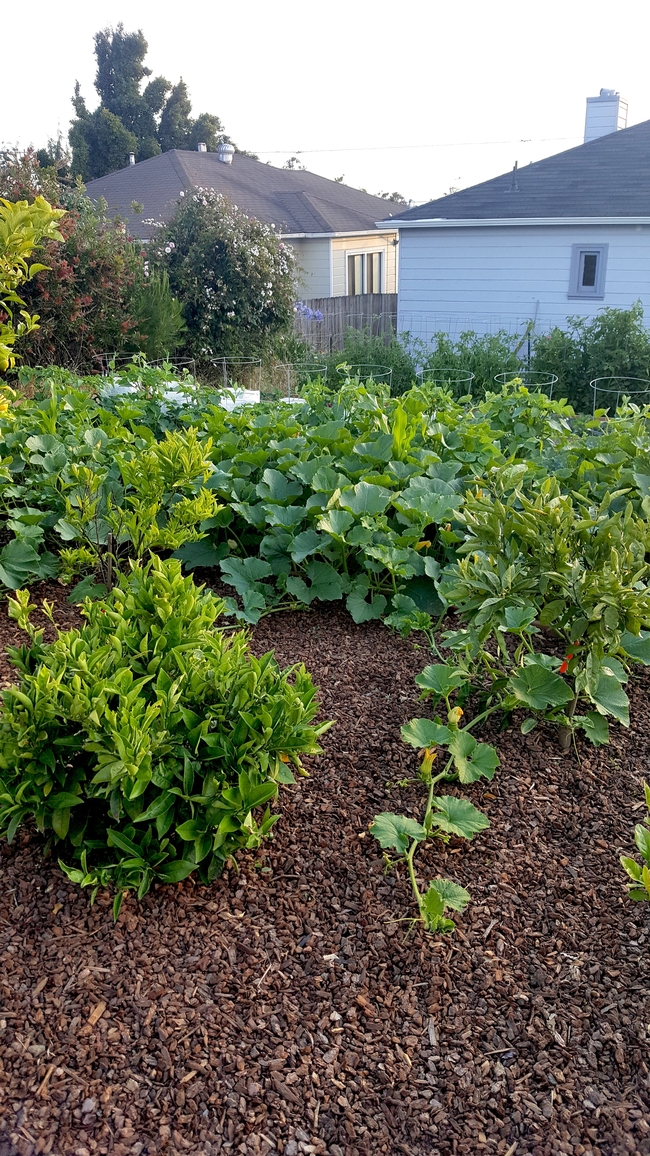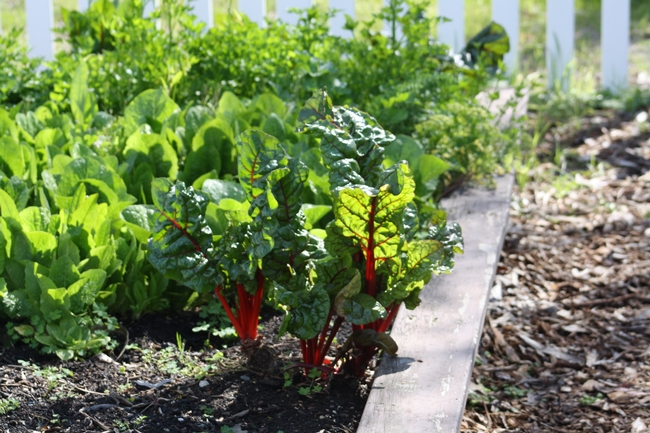If your company does residential landscape pest control, your employees should be trained to know what to do when they encounter a vegetable garden, or fruit or nut trees in a yard (Figure 1). Their training should include how to answer a customer's questions about the safety of their pesticides around vegetables or herbs. Talking to a customer about the edible plants in their garden so you don't accidentally spray their plants might save that account from subsequent cancellation.

Is it appropriate for a technician to recommend that a resident simply wash their vegetables after having their yard treated for say, mosquitoes, or should the vegetables be thrown away? What about a perimeter spray around the home? The answer to these questions depends on whether the plants were directly exposed to the sprayed pesticide and what the product label says about proximity to edible crops.
Insecticides used for perimeter sprays and mosquito control generally don't allow application to edible plants. For example, the Suspend Polyzone label states “do not apply this product to edible crops.” The Termidor SC label says, “DO NOT treat within a distance of one foot out from the drip line of edible plants. DO NOT treat fruit-bearing or nut-bearing trees.” Some product labels make no mention of vegetables or edible crops at all. If application on edible plants is not explicitly mentioned, it is not allowed.
Will pesticides make a plant toxic?
Many insecticides, including some common active ingredients familiar to urban pesticide applicators, are used legally on agricultural crops. This is allowed by the United States Environmental Protection Agency (US EPA) only if that pesticide has been granted a tolerance for a given crop, and certain days-to-harvest intervals are followed. These rules work to ensure that any pesticide residues left after a pesticide application are below levels of concern for human health. The 2019 Pesticide Data Program survey by USDA shows that this system works. Out of 10,000 market food samples analyzed in the study, nearly 99% had residues well below the EPA established tolerances. More than 42% had no detectable pesticide residue.
Insecticide residues on plants are not necessarily acutely toxic, especially when label directions are followed, and adequate time passes to allow the product to naturally degrade. The products used by professional pesticide applicators may contain the same active ingredients used by farmers; but they may differ in concentration and formulation. Most importantly, insecticides used for landscapes and homes do not carry food-treatment labels, so they cannot legally be used on edible crops.
Talstar products, for example, consist of the active ingredient bifenthrin, the same active ingredient used by farmers and even home gardeners under a variety of trade names. The Talstar® P label however, says "do not use on edible crops." You must follow the label for the product you are using.
Spray contamination
If an insecticide is deliberately sprayed on an edible crop or plant, and the product is not labeled for such use, the plant would not be considered safe by EPA standards. The implication is that the whole plant, or at least the edible parts, should be thrown away. Your customer could replant unless that is prohibited by the label.
Backpack mistblowers are commonly used for applying residual insecticides in areas such as mosquito resting sites; but mists should be applied carefully to avoid drift onto fruit and nut trees and vegetable gardens.
Labels generally do not, however, prohibit use of these products in the vicinity of a vegetable garden. Take care to keep sprays directed away from vegetable gardens, so that any incidental drift from nearby spraying does not land on edible plants. Thermal foggers and ULV applications used nearby should leave insignificant residues if the application orifices are always directed away from edible plants.
Applicators should always be aware of weather conditions and the locations of edible plants. If wind is blowing toward a garden, upwind applications should be avoided.
What should you do if a fruit, nut, vegetable, or herb is accidentally sprayed? Notify the customer that an accidental spray contamination has occurred. Annual plants should be pulled. For both annual and perennial plants, the produce must be discarded by the customer and not eaten.
Systemic insecticides
Some insecticides are "systemic," meaning they have enough water solubility to be taken up by plant roots and translocated to other parts of the plant. Although the EPA allows some systemic insecticides on crops, in general systemics are not labeled for use on food crops because they can leave residues in edible plant tissues that do not quickly degrade.
Insecticides containing neonicotinoids and acephate are examples of professional grade insecticides that may be systemic in plants. These include products like Premise, Alpine, Tandem, Transport, Temprid, Orthene and others. Herbs and other root or leafy vegetables exposed to systemic insecticides should be considered contaminated for the season and should not be consumed.
Some termiticides can also be systemic in plants, leading to concerns about vegetable gardens and fruit trees planted next to homes treated for termites. Fipronil, for example, is slightly systemic in some plants; and the Termidor SC label says not to apply around edible plants. The label does not say explicitly how far away an edible plant must be, although the Premise Pro label (whose active ingredient, imidacloprid, is much more water soluble) is more specific. It says to "not treat within a distance of one foot out from the drip line of edible plants." The Premise instruction is probably a good, conservative guidelines for all termiticides. Keep the outermost leaves of garden plants at least a foot away from any soil-applied termiticide.
Washing Crops
A concerned customer whose nearby yard or house perimeter has been treated with an insecticide spray should consider washing their vegetables or other harvested edibles. Washing is a good idea whether p
esticides have been used or not. The best washing technique is to gently rub off any dirt while holding the produce under running water. This is a great way to remove dust, microorganisms, and any traces of pesticides from vegetable and fruit surfaces.
Would you recognize an edible plant?

Can you and your technicians and applicators tell basil from begonia, mint from marigold, or pear from poplar? Applicators following label directions around a home needs to be aware of what plants are present. You don't have to be a botanist or know all the local tree species; but you should recognize the most common fruit and nut trees, herbs, and vegetables (Figure 2).
When visiting a residence for the first time, ask your customer if they have any herbs, fruit trees, nut trees, or vegetables. Gardeners may plant edible plants within flower gardens, so they might have a basil plant or a tomato plant growing among the daisies. Assume your customers don't use pesticides in their vegetable garden and avoid these areas accordingly.
Your customers will appreciate any extra consideration you give to their edible garden plants. Treat them well and they might even greet you at the door with a big bag of zucchini!
Based on the article “Bugs and basil: Insecticides and veggies don't always mix” by Dr. Mike Merchant, Texas AgriLife Extension at https://insectsinthecity.blogspot.com/2018/08/pesticides-and-veggie-gardens.html
[Originally featured in the Fall 2021 edition of the Green Bulletin Newsletter for structural and landscape pest professionals.]